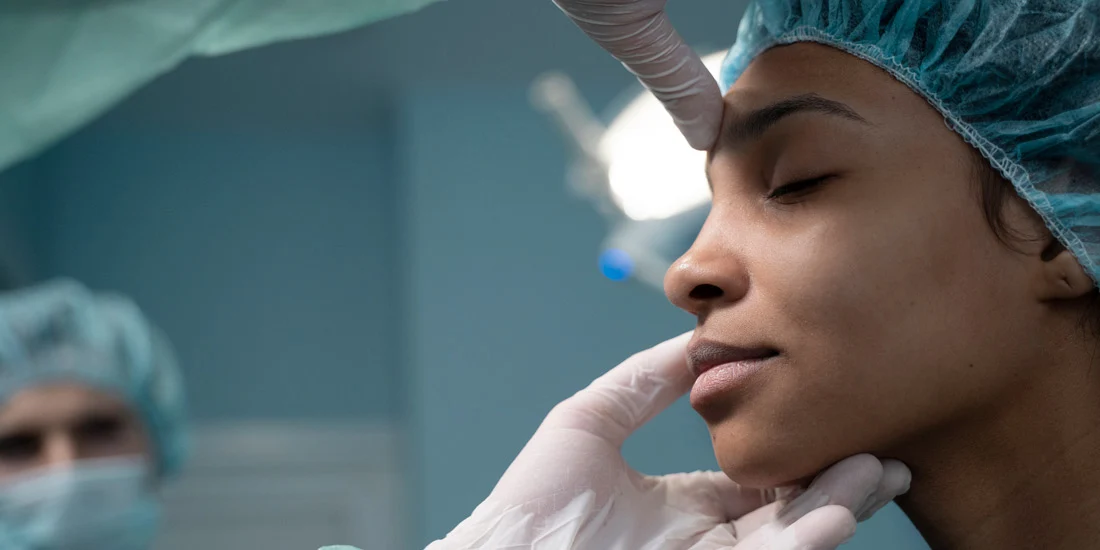
Plastic Surgery Financing: Best Options for 2025-2026
12 Min Read
- Key takeaways
- Average prices for popular cosmetic and plastic surgery
- How to finance plastic surgery
- Other ways to cover plastic surgery costs
- How to qualify for cosmetic surgery financing
- Can you get a personal loan for cosmetic surgery with poor credit?
- How to get a loan for plastic surgery
- Key factors to keep in mind before taking out a loan for plastic surgery
- Bottom line
- FAQ
Key Takeaways
- The cost of plastic surgery is high: the most popular procedures in the U.S. in 2024 ranged from $3,000 to $19,000.
- Financing options include personal savings, insurance coverage, clinic installment plans, medical credit cards, personal loans, 401(k) and home equity loans.
- Your credit score, income, debt-to-income ratio, and employment stability are key factors that affect loan approval.
- Plastic surgery financing for people with bad credit is possible, but borrowers typically face less favorable loan terms.
People turn to plastic surgery for different reasons. Some want to change their appearance, while others need it after health problems and injuries. The 2024 Plastic Surgery Statistics confirm this demand: liposuction, breast augmentation, abdominoplasty, breast lift, and blepharoplasty were the five most requested procedures.
Among women, comprehensive solutions, such as the mommy makeover, have gained popularity, combining abdominoplasty, breast lift, and liposuction. Male plastic surgery is also gaining popularity. In 2024, men accounted for approximately 7% of facelifts and 13% of eyelid surgeries.
At the same time, plastic surgery is one of the most expensive areas of medicine. The cost depends on the type of procedure and the clinic, but typically remains high, which becomes an obstacle for many patients. Luckily, various financing options offer a practical way to manage these expenses.
Average Prices for Popular Cosmetic and Plastic Surgery
The price is one of the first things people consider when they start thinking about plastic surgery. Below are some of the most common procedures with their typical cost ranges:
| Procedure | Description | Average Cost |
|---|---|---|
| Breast Augmentation | Enhances breast size and shape using implants | $4,575 – $8,000 |
| Breast Lift (Mastopexy) | Raises and reshapes sagging breasts | $6,500 – $11,000 |
| Breast reduction (aesthetic patients only) | Reduces breast size by removing excess tissue for improved comfort and appearance | $7,000 – $12,500 |
| Abdominoplasty (Tummy Tuck) | Removes excess skin and tightens abdominal muscles | $8,000 – $13,500 |
| Liposuction | Removes unwanted fat from chosen areas | $4,300 – $7,500 |
| Facelift (Rhytidectomy) | Reduces visible signs of face and neck aging | $12,000 – $19,000 |
| Eyelid Surgery (Blepharoplasty, Upper) | Improves the appearance of the upper eyelids | $3,000 – $5,500 |
| Eyelid Surgery (Lower) | Removes bags or excess skin under the eyes | $3,700 – $6,500 |
| Nose Reshaping (Rhinoplasty) | Changes the shape or size of the nose | $7,500 – $12,500 |
| Coolsculpting (Cryolipolysis) | Non-surgical fat reduction that freezes and eliminates fat cells | $2,000 – $4,000 per course |
How to Finance Plastic Surgery
If you have the full amount available in your savings account or in cash, it’s best to pay for the procedure upfront. This way, you avoid interest charges, debt obligations, and the risk of getting stuck in long repayment plans. To understand the total cost, request detailed estimates from several board-certified surgeons. These estimates should include the surgeon’s fee, anesthesiologist services, operating room costs, lab tests, and post-operative care.
If your own funds are not enough, check your health insurance coverage. Cosmetic procedures are typically excluded, but reconstructive surgeries (for example, those resulting from injuries or congenital conditions) may be partially covered. To apply, your surgeon will need to prepare a medical necessity statement, supported by lab results and photos, and you must submit a request for prior authorization. Even if insurance covers 20–40% of the bill, it can significantly ease the financial burden.
Another option is a clinic’s in-house payment plan for plastic surgery. This usually takes the form of installment payments with a fixed schedule: a deposit after the consultation, another payment when booking the surgery date, and the balance closer to the procedure itself. This setup works like staged financing. Always request a written agreement with exact amounts and due dates, as well as terms covering administrative fees, interest on installments, and penalties for late payments.
Other Ways to Cover Plastic Surgery Costs
If personal savings are insufficient and insurance does not cover the expenses, a loan becomes the main option. A loan is always a debt, but with a realistic repayment plan, it can become a reliable means of financing operations.
Medical Credit Cards
Medical credit cards, such as CareCredit, are designed specifically to cover healthcare expenses. Some cards offer 0% annual interest for 12 months, provided the debt is fully repaid within this period. This can save significantly compared to a standard credit card. However, if you do not repay the debt during the grace period, the interest rate may be retrospectively increased to 26–29% on the entire balance.
Personal Loans
A personal loan for cosmetic surgery allows you to get a fixed amount (usually up to $50,000) from a bank, credit union, or online lender. The major advantage is predictability: from the outset, you know the exact monthly payment and the repayment period. For people with good credit history, interest rates can be as low as 7–10% annually, which is much cheaper than keeping a balance on a credit card. If you have a poor credit history, the rate can rise to 25% or higher.
Installment Loan
If you do not need a large amount, small installment loans from online lenders can be a simple solution. The amount does not exceed $5,000, but it is often sufficient to cover the cost of an inexpensive operation or to settle the final balance of a bill. Approval typically occurs quickly, and the funds can be credited within one business day. Repayment is made in equal monthly payments, but interest rates may be higher, especially if the credit score is low.
Personal Credit Cards
Using a personal credit card for plastic surgery may seem like the simplest way—swipe, and everything is ready. The advantage is speed, and if you qualify, introductory offers of 0% interest annually for 12–18 months. After the introductory period, credit card interest rates often reach 20–30%, which, over time, can significantly increase the cost of the operation. This option makes sense if you are organized and disciplined.
401(k) Loan
This option means using your retirement savings. In essence, it is a loan to yourself with an interest rate of around 5–6%, and the interest paid is returned to your account. This is a real advantage compared to paying interest to a bank. However, while the loan remains unpaid, your retirement money does not grow, which can be costly in the long term. This option is suitable if you have a stable job and are seeking a relatively affordable credit option.
Home Equity Loan
A loan or line of credit secured by home equity typically offers larger amounts at rates of 6%–8% with repayment in installments over several years. This means your monthly payment is smaller and more manageable. However, the risk is high: if you cannot repay it on time, you may put your home at risk. For financially stable homeowners, this can be one of the cheapest ways to finance an operation, but it requires confidence in your ability to make payments on time.
How to Qualify for Cosmetic Surgery Financing
When you apply for cosmetic surgery financing, lenders want to make sure that you will be able to handle the payments without problems. They check your identity and your credit score, but this is only part of the picture. Your income and debt-to-income ratio, which represents the portion of your earnings that goes toward repaying other debts, are also key factors.
Additionally, lenders look at how long you have been working in one place and how reliable your source of income is. Your payment history is also important: if you have always paid your bills on time, it confirms your creditworthiness.
When it comes to documents and information, you typically need to provide the following items:
- Valid ID
- Proof of residence
- Social Security number
- Recent pay stubs or bank statements
- Bank account and routing numbers
Sometimes an estimate of expenses from your surgeon is also required to confirm the validity of the loan amount. Plus, some lenders may apply specific minimum credit score requirements you need to meet to qualify. However, options for individuals with bad credit are still available for those who can demonstrate a stable income and a reasonable level of debt.
Can You Get a Personal Loan for Cosmetic Surgery with Poor Credit?
A low credit score doesn’t mean plastic surgery is out of reach. Many lenders still approve loans, though the rates may be higher and the amounts smaller. The key is to focus on what fits your budget: if the monthly payment feels heavy, it’s better to borrow less or wait until you’re ready. These loans usually work like any other personal loan — you get the money upfront, then repay it in fixed monthly installments. With the right approach, financing can stay manageable, and at 1F Cash Advance, you can explore options even if your credit history isn’t perfect.
How to Get a Loan for Plastic Surgery
Paying for plastic surgery with a loan is easier than it may seem. Here are five common steps you typically need to take:
- Compare lenders and offers. Consider options from banks, credit unions, and online lenders. Compare interest rates, loan amounts, repayment terms, and fees to find the best fit.
- Gather required documents. Most lenders will require proof of income, identification, bank statements, and occasionally a cost estimate from your surgeon. Having these ready speeds up approval.
- Apply and review approval terms. Submit your application and carefully read the offer. Pay attention to APR, repayment schedule, and any extra charges before signing.
- Receive funds and plan repayment. Once approved, the loan amount is usually paid in a lump sum on the same day or the next day. Use it to pay your clinic directly, then stick to the repayment schedule to avoid late fees or extra interest.
Key Factors to Keep in Mind Before Taking out a Loan for Plastic Surgery
Before signing a loan agreement, assess your repayment capabilities and the loan terms realistically. This will help you avoid unnecessary overpayments and maintain financial stability. Below are the key points to consider in advance.
Determine the Loan Amount
Borrow only the amount you really need to pay for the surgery. Do not take out a loan “with a margin” — this will lead to overpayments. Calculate your expenses and ensure the loan fits within your budget.
Consider Your Credit Score
Lenders assess your payment discipline and your history of past loans. A high score increases the chances of approval and a favorable rate. Even with a poor history, it is essential to make timely payments in the future to improve your credit record.
Understand the Loan Type and Fees
When choosing a loan, clarify all the details: whether there is an origination fee, penalties for late payments, or fees for early repayment. Transparent terms will help you avoid unnecessary costs.
Compare Interest Rates
Review offers from different banks and online lenders. Look for the lowest rates, reasonable fees, and flexible terms. Pay attention to promotions with reduced rates — they can help you save money.
Create a Repayment Plan
Calculate the monthly payment so that it does not overload your budget. Understanding the terms, total amount, and full cost of the loan will give you confidence and help you avoid delays and penalties.
Bottom Line
The demand for cosmetic surgery is growing, and many people are considering it, but the high cost can feel like an obstacle. The good news is that you do not have to pay the full amount at once and can make manageable monthly payments instead. It is important not to rush and not to agree to financing right in the doctor’s office. Just as you carefully chose the specialist for your procedure, you should also take the time to find a financial option that is safe and right for you.
FAQ
What are the best options to finance cosmetic surgery?
The best options are those that do not create debt: paying with your own savings, insurance coverage (if the procedure is medically justified), or an interest-free installment plan offered by the clinic. If this is not possible, choose a loan with the lowest possible interest rate, transparent terms, and monthly payments that you can afford.
What credit score is usually required to get financing for plastic surgery?
Many lenders expect a minimum credit score of 620. But the score is not the only factor. Lenders also evaluate your income, job stability, debts, and payment history. Even if the score is low, you can still qualify for a loan. Although no one can promise guaranteed financing for plastic surgery, at 1F Cash Advance, we work with people who have a bad credit history.
Can I apply for plastic surgery financing with no credit check?
Yes, there are lenders who can offer a loan without a traditional credit check. Many also use pre-qualification, which shows you estimated terms without affecting your score.
Do surgeons or clinics offer payment plans for plastic surgery?
Yes, many clinics offer their own payment plans. Typically, you pay a deposit at the consultation, a portion of the amount when scheduling the surgery, and the remaining balance either before the operation or in installments. Be sure to obtain the agreement in writing and clarify all the details, including fees, penalties, and payment dates.
Can medical insurance cover the cost of plastic surgery procedures?
Insurance companies usually consider cosmetic surgery to be “non-essential” and do not provide coverage for it. But there are exceptions: if the surgery is reconstructive (restoration after injury, correction of congenital defects, recovery after mastectomy) and recognized as medically necessary, insurance may cover a portion of the cost.
Is a credit card for plastic surgery a good option?
A credit card can be a convenient solution if you obtain one with 0% annual interest for an introductory period and are certain that you will repay the balance within this timeframe. But if the balance remains after the grace period ends, standard rates often reach 20–30% annually. This makes the surgery much more expensive. Use the card only if you have a clear repayment plan.
Get approved for your plastic surgery loan fastApply



